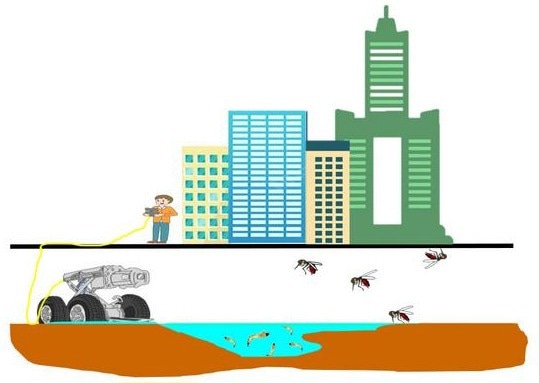According to a new study, unmanned ground vehicles could be utilized to determine and eliminate the breeding sources of mosquitos that carry dengue fever in urban areas.

Artist rendering of experimental setup. Image Credit: Liu et al., 2023, PLOS Neglected Tropical Diseases, CC-BY 4.0 (https://creativecommons.org/licenses/by/4.0/)
The study has been published this week in PLOS Neglected Tropical Diseases by Wei-Liang Liu of the Taiwan National Mosquito-Borne Diseases Control Research Center and collaborators.
Dengue fever is known as an infectious disease that has been caused by the dengue virus and spread by various mosquito species in the genus Aedes, which also spread yellow fever, chikungunya, and zika. By adopting the process of urbanization, sewers have turned out to be easy breeding grounds for Aedes mosquitos, and the majority of the present mosquito monitoring programs fight to track and examine the density of mosquitos in such hidden regions.
In the new control effort that has been taken, scientists integrated a wire-controlled cable car, crawling robot, and real-time monitoring system into an unmanned ground vehicle system (UGV) that has the potential to take high-resolution and real-time images of areas within sewers.
From May to August 2018, the system was dispensed in five administrative districts in Taiwan, Kaohsiung City, with covered roadside sewer ditches that have been presumed to be hotspots for mosquitos. Mosquito gravitraps were known to be the places above the sewers to track the effects of the UGV intervention on adult mosquitos in the area.
In almost 20.7% of inspected sewers, the system discovered traces of Aedes mosquitos in stages ranging from larvae to adults. In positive sewers, extra prevention control measures were performed, using either high-temperature water jets or insecticides. Instantly following such interventions, the gravitrap index (GI)—known to be a measure of the adult mosquito density nearby— went down considerably from 0.62 to 0.19.
“The widespread use of UGVs can potentially eliminate some of the breeding sources of vector mosquitoes, thereby reducing the annual prevalence of dengue fever in Kaohsiung city,” state the authors.
Journal Reference
Chen, Y-X., et al. (2023) Use of unmanned ground vehicle systems in urbanized zones: A study of vector Mosquito surveillance in Kaohsiung. PLoS Neglected Tropical Diseases. doi.org/10.1371/journal.pntd.0011346.